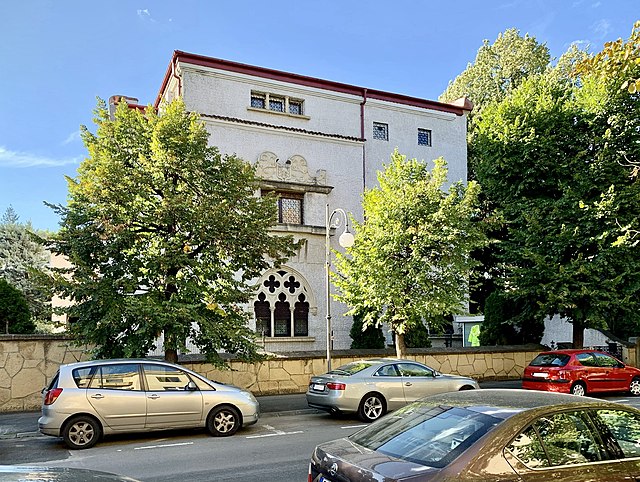Eclecticism is a conceptual approach that does not hold rigidly to a single paradigm or set of assumptions, but instead draws upon multiple theories, styles, or ideas to gain complementary insights into a subject, or applies different theories in particular cases. However, this is often without conventions or rules dictating how or which theories were combined.
The grand foyer of the Palais Garnier, by Charles Garnier, 1860–1875. Stylistically, it aimed for a Baroque opulence through lavishly decorated monumental structures that evoked Louis XIV's Versailles. However, it was not just a revival of the Baroque, being more of a synthesis of Classicist styles, like Renaissance, Baroque, Rococo, Neoclassicism etc. Thus, it is an example of eclecticism.
Early Romanian Revival house on Strada Grigore Alexandrescu in Bucharest, Romania, unknown architect, c. 1900, that mixes Beaux-Arts and Romanian Revival elements and proportions
Building no. 45 on Rue de Courcelles in Paris, unknown architect, unknown date, an example of 19th century architecture that can be called "Eclectic" due to the fact that it uses elements from multiple Classicist styles, like the French Baroque and the Louis XVI style
Otto Gagel House in Bucharest, Romania, 1937, by Anton Curagea and Ion Giurgea, in a style known as "Moorish" or "Moorish-Florentine", which uses eclectically Romanesque, Gothic and Renaissance elements in civic architecture, but is also characterized by big plane surfaces, due to the influences of Modern architecture
Syncretism is the practice of combining different beliefs and various schools of thought. Syncretism involves the merging or assimilation of several originally discrete traditions, especially in the theology and mythology of religion, thus asserting an underlying unity and allowing for an inclusive approach to other faiths. While syncretism in art and culture is sometimes likened to eclecticism, in the realm of religion, it specifically denotes a more integrated merging of beliefs into a unified system, distinct from eclecticism, which implies a selective adoption of elements from different traditions without necessarily blending them into a new, cohesive belief system. Syncretism also manifests in politics, known as syncretic politics.
The gods Persephone-Isis and Hades-Serapis, an example of Greco-Egyptian syncretism
The use of elephant-shaped column brackets in buildings of the Lahore Fort reflects Hindu influences on Mughal Architecture during the reign of Akbar. Islam forbids representation of living figures.
The god Hermanubis, an example of Greco-Egyptian syncretism
The god Taranis-Jupiter, an example of Romano-Celtic syncretism








